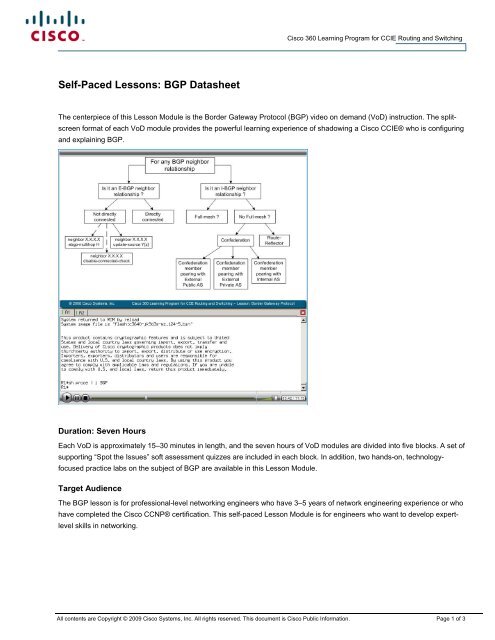Self-Paced Lessons BGP Datasheet.pdf - The Cisco Learning Network
Self-Paced Lessons BGP Datasheet.pdf - The Cisco Learning Network
Self-Paced Lessons BGP Datasheet.pdf - The Cisco Learning Network
Create successful ePaper yourself
Turn your PDF publications into a flip-book with our unique Google optimized e-Paper software.
<strong>Self</strong>-<strong>Paced</strong> <strong>Lessons</strong>: <strong>BGP</strong> <strong>Datasheet</strong><br />
<strong>Cisco</strong> 360 <strong>Learning</strong> Program for CCIE Routing and Switching<br />
<strong>The</strong> centerpiece of this Lesson Module is the Border Gateway Protocol (<strong>BGP</strong>) video on demand (VoD) instruction. <strong>The</strong> splitscreen<br />
format of each VoD module provides the powerful learning experience of shadowing a <strong>Cisco</strong> CCIE® who is configuring<br />
and explaining <strong>BGP</strong>.<br />
Duration: Seven Hours<br />
Each VoD is approximately 15–30 minutes in length, and the seven hours of VoD modules are divided into five blocks. A set of<br />
supporting “Spot the Issues” soft assessment quizzes are included in each block. In addition, two hands-on, technologyfocused<br />
practice labs on the subject of <strong>BGP</strong> are available in this Lesson Module.<br />
Target Audience<br />
<strong>The</strong> <strong>BGP</strong> lesson is for professional-level networking engineers who have 3–5 years of network engineering experience or who<br />
have completed the <strong>Cisco</strong> CCNP® certification. This self-paced Lesson Module is for engineers who want to develop expertlevel<br />
skills in networking.<br />
All contents are Copyright © 2009 <strong>Cisco</strong> Systems, Inc. All rights reserved. This document is <strong>Cisco</strong> Public Information. Page 1 of 3
Recommended Prerequisites and Corequisites<br />
<strong>Cisco</strong> 360 <strong>Learning</strong> Program for CCIE Routing and Switching<br />
Learners advance through the <strong>Cisco</strong> 360 <strong>Learning</strong> Program for CCIE Routing and Switching in three distinct stages, and this<br />
<strong>BGP</strong> lesson should be completed in the first stage. It is also recommended that this lesson be completed with these lessons:<br />
CCIE R&S Lesson: Data Link Layer Technologies<br />
CCIE R&S Lesson: Frame Relay<br />
CCIE R&S Lesson: IGP Routing Protocols<br />
Lesson Module Objectives<br />
Upon completion of this self-paced Lesson Module, learners should be able to formulate well-defined mental simulations to<br />
perform these <strong>BGP</strong> tasks with the minimally described parameters that are commonly found in CCIE-level tasks.<br />
Form all types of <strong>BGP</strong> neighbor relationships<br />
Originate <strong>BGP</strong> updates<br />
Filter <strong>BGP</strong> updates<br />
Aggregate <strong>BGP</strong> updates<br />
Manipulate <strong>BGP</strong> path selection<br />
Lesson Module Outline<br />
<strong>The</strong> VoDs in this Lesson Module discuss these topics:<br />
Block 1: Introduction to <strong>BGP</strong> and <strong>BGP</strong> Neighbor<br />
Relationship Formation<br />
<strong>BGP</strong> Neighbor Relationship Basics<br />
E<strong>BGP</strong> Issues Using E<strong>BGP</strong>-MULTIHOP and TTL-<br />
SECURITY<br />
I<strong>BGP</strong> Issues with Route Reflectors<br />
I<strong>BGP</strong> Issues with Confederations<br />
Block 2: <strong>BGP</strong> Fundamental Operations<br />
Originating <strong>BGP</strong> Updates<br />
Addressing Next-Hop Reachability Issues<br />
Block 3: Filtering <strong>BGP</strong> Updates and Aggregation<br />
By Prefix<br />
By AS-Path Using Regular Expressions<br />
By Community<br />
Well-Defined Communities<br />
Lab Outline<br />
User-Defined Communities<br />
Combining Methods Above with Route Maps<br />
Aggregating <strong>BGP</strong> Updates<br />
Block 4: <strong>BGP</strong> Path Selection via Attribute<br />
Manipulation<br />
Review of the <strong>Cisco</strong> <strong>BGP</strong> 13-Step Path Selection<br />
Process<br />
Manipulating Outbound Traffic with <strong>BGP</strong><br />
Using the Administrative Weight<br />
Using the Local Preference Attribute<br />
Manipulating Inbound Traffic with <strong>BGP</strong><br />
Using the AS-Path Prepend Command<br />
Block 5: <strong>BGP</strong> Features<br />
Securing <strong>BGP</strong> Neighbor Relationships<br />
Implementing <strong>BGP</strong> Route Dampening<br />
This Lesson Module contains two hands-on labs that focus on the <strong>BGP</strong> topics in the VoDs. Learners must supply the lab<br />
equipment that is required to run the labs. Each of these hands-on, technology-focused scenarios consists of:<br />
A scenario written with CCIE-level configuration tasks<br />
A detailed Answer Key<br />
<strong>The</strong> web-based and highly interactive Mentor Guide<br />
All contents are Copyright © 2009 <strong>Cisco</strong> Systems, Inc. All rights reserved. This document is <strong>Cisco</strong> Public Information. Page 2 of 3
Lab Topology<br />
<strong>The</strong> following minimal topology is required to perform the <strong>BGP</strong> Lesson Module labs.<br />
i<strong>BGP</strong><br />
<strong>Cisco</strong> 360 <strong>Learning</strong> Program for CCIE Routing and Switching<br />
For More Information<br />
For more information about <strong>Cisco</strong> 360 <strong>Learning</strong> Program for CCIE Routing and Switching, go to www.cisco.com/go/360.<br />
<strong>The</strong> <strong>Cisco</strong> 360 <strong>Learning</strong> Program for CCIE Routing and Switching <strong>Learning</strong> Portal is available at http://cisco360.cisco.com.<br />
Printed in USA 05/09<br />
All contents are Copyright © 2009 <strong>Cisco</strong> Systems, Inc. All rights reserved. This document is <strong>Cisco</strong> Public Information. Page 3 of 3

















